Weird Deep Sea Creatures
Apr 28, 2015 04:12:25 #
Unless you spend a lot of time reading about marine fish, there are probably a few here that you may not have ever seen before.
My favorite is was recently given the rather dubious distinction of being the "ugliest creature in all of nature"''; Actually, I think the blobfish lookas more "pathetic" than it does ugly; it's also the only fish in the ocean that bears a striking resemblance to a Democrat....'er...I mean a "little old man"; (who's probably a Democrat anyway? ) Anyway, unless you have ever seen a blobfish, I can guarantee you that there is no other fish that looks like this thing!
#1. Frilled Shark
A rare frilled shark, whose species dates back 80 million years, was caught in a fishing trawler off Australia's coast.
"It's a freaky thing," Simon Boag, the chief executive officer at South East Trawl Fishing Association, told Australia's ABC Rural. "I don't think you would want to show it to little children before they went to bed."
The association said the frilled shark is often referred to as a "living fossil." It is described as having an eel-like body with three fins on its back. It gets its name from the six pairs of gill slits that give it a fringed appearance.The shark, which reaches about 6 feet in length, has 300 needle-shaped teeth in 25 rows and it is believed to capture its prey by bending its body like a snake. This particular shark was nearly as large as they grow and caught at 2,296 feet below the surface, the association said.This guy was just unlucky," Boag said, since the shark was caught in shallower depths than it is usually found.David Guillot, the captain of the Western Alliance Vessell, toldradio station 3AW Drive that the shark was unlike any fish he's ever seen."I've been at sea for 30 years and Ive never seen a shark that looks like that," he said. "It was like a large eel, probably 1.5 meters [5 feet] long, and the body was quite different to any other shark I'd ever seen."
#2. Pacu Fish
Pacu Fish, also called the "ball cutter" fish because they k**l fishermen by biting off their testicles. Man-eating predators have always been part of legend and folk-lore, but here we have news of a real-life monster, interested in only one part of the human anatomy the testicles. The monster in question is in fact a 40lb fish called Pacu, found in the waters of Papua New Guinea, and in the Amazon River of South America. The Pacu are notorious for having eaten up the testicles of swimmers and anglers caught unawares, leaving them to bleed to death. This has led to the creatures being nicknamed Ball Cutter fish. Initially, the villagers could only describe the monster-fish as something mysterious, like a human in the water.
They finally got to see the predator up-close when a Pacu fish was recently caught by Jeremy Wade, a 53-year old British Fisherman, as a part of his TV series called River Monsters. The muscular fish was hard to catch, but Wade managed to track it down, reel it into his boat and wrestle it into submission. When he opened its jaws up with his hands, the teeth of the Pacu were found to be quite similar to human teeth. Fortunately, the Pacu was unable to bite Jeremy Wade's testicles off.
The Pacu fish are actually native to the Amazon, and were introduced to Papua New Guinea only about 15 years ago. Traditionally vegetarian, the fish used their molar-like sharp teeth to crack open nuts (no pun intended) and seeds. When veggie food wasnt available in their new surroundings, they had to resort to eating meat. I suppose this is when they discovered a particular liking towards the meat of human testicles. All we can say is that if you ever happen to be swimming or fishing in the rivers of Papua New Guinea, be sure to guard those family jewels!
#3. Stargazer Fish
This ugly beast hides in the sand and when it senses something near by it zaps it with electricity to stun it and then eats it right up. Thats right, this thing shoots lightning bolts out of its face!
#4. Pacific Barrel Eye Fish
This fish gets its name from large eyes that are literally shaped like barrels, topped with beautiful green lenses. Also known as the Macropinna microstoma, its head is completely t***sparent, filled with fluid. This unique creature lives at depths of around 2000 to 2,600 ft. The Pacific Barreleyes see-through head may seem weird, but it has a very clear purpose to help it see better in the dark waters that it inhabits.
The Barreleyes eyes have been found to be incredibly sensitive, snapping up any stream of light available. Unlike most other fish, both the eyes are in the front of the head and point in the same direction, which gives it amazing binocular vision. So the Barreleye is able to spot faint objects that other fish cannot, making it a feared predator. Its extremely fascinating, how it searches for prey. It starts off by staying still, eyes pointed upward in search of prey. Sometimes the eyes are rotated to face forwards, or the eyes are still and the body is rotated so that the mouth is pointing in the same direction as the eyes. When tiny silhouettes of prey are spotted, the Barreleye moves in exactly the same direction to catch them. Its flat, horizontal fins help it to swim very precisely. This method is so efficient that it is sometimes able to even snatch food away from the stinging tentacles of other deep sea creatures. Its mouth is really tiny so thats of great help as well, and the t***sparent shield makes it immune to stings.
#5. Blobfish
The Blobfish, or Psychrolutes Marcidus, is one of the strangest aquatic creatures found in Australian and Tasmanian waters. They are in the deep sea family of Psychrolutidae, which are considered extremely rare. They are near extinction however, are not easy to obtain and will die if the water pressure is too low. They live on the sea floor, which is eighty times denser than the water at sea level. Just getting down there is difficult for fishers. Track up Blobfish on Google, and you will find very few pictures and references while blob fish is at sea. What makes Blobfish so unique is the shape of its face. When looked straight on, it looks like a human face. A large flap of skin folds over the wide mouth is like a nose. The two eyes are visible as well. The head of a Blobfish weighs a surprising 1/3 of its total body weight. The rest of the body descends into a short tail.The reason Blobfish survive at such a low sea level is due to the gelatinous like flesh it has, which is just a little lighter than water. They contain no muscle at all, so being able to swim without it is essential for it to survive. It helps it float and reduces the pressure on the Blobfish body. At the bottom of a sea, the Blobfish basically remains stationary throughout its life. They rarely move unless food is found nearby, otherwise they will wait for prey to come close. Studies show the Blobfish diet consists mainly of urchins, mollusks, crabs, lobsters, and other slow-moving ocean bottom feeders. When something edible comes by, it waits for it to come close. Even though Blobfish literally have to muscle, they are still able to open and close their mouth. It is currently unknown of how much they eat in an amount of time. A Blobfish barely moves at all when feeding. Where prey is scarce, some Blobfish will die simply of starvation.
#6. D**gonfish
The Deep-sea D**gonfish, as the name states, lives in the deep-sea of the Pacific ocean. The D**gon fish tends to live around 1000 to 3000 meters below the surface. Some D**gonfish have even been found at depths of 5000 meters. At these depths, the conditions are very extreme. The pressure can range from 200 to 600 atmospheres (atm) and the temperatures fall just below four degrees Celsius. The D**gonfish lives below the Bathyal zone where no light reaches. The Bathyal zone starts at about 220 meters. Past this point, there is no light, and it is deep enough to not be affected by storms or ocean currents, making the environment where the d**gonfish lives utterly still.
Physical Characteristics
To deal with the pressures, the d**gon fish has a very minimalized skeleton except for the jaws and other parts used for feeding.They have large, recurved teeth that can either be tightly bound or hinged, allowing them to fall inward while eating, depending on the species. The d**gonfish also has a second set of jaws located in the branchial basket, which houses the gills as well as this second set of jaws. The d**gonfish has a very odd characteristic in that certain genera of d**gonfish are missing the two through seven vertebras in their spine. This has been found to be due to the developmental characteristics of the d**gonfish. In most fish, the spine develops from head to tail, but in d**gonfish it develops in the opposite direction. These missing vertebras allow the d**gonfish to have an increased flexibility in their head, allowing them to eat larger prey. The d**gonfish, like other deep-sea predators, have light producing organs called Photophores along their body and on a flesh like extension of the lower jaw called a barbell. These photophores are also found on the pectoral fins. The d**gonfish, unlike most fish, has a scaleless body. Their body has a slimy, flesh-like outside very similar to an eel.
#7. Anglerfish
There are more than 200 species of anglerfish, and while some can grow longer than three feet, most are less than a foot, reports National Geographic. The females of all species, however, carry a fishing-pole-like spine topped with a glowing "lure" made of flesh. This feature earns the fish its name, as it uses th elure to attract prey close enough to be snatched up its toothsome jaw.
Fewer than half a dozen anglerfish have ever been captured on film.
#8. Vampire Squid
"Vampire squid from hell" is the t***slation of this squid's latin name - Vampyroteuthis infernalis. Aside from this nice name, the squid has some other interesting, possibly infernal, characteristics. Is a bit scary-looking with it's squat, puffy, zombie-ish body. Some are black with red eyes, although not all of them. It has big round eyes that can be blue or reddish. The skin can also be reddish or pale. It does not have vampire fangs but does have a big white beak. It has blue blood. The tentacle arms are covered by tiny, hairlike features called cirri. The arms have suckers on the outer sides. They can resemble an umbrella or appear bell-shaped with their webbed arms stretched out. It can turn itself inside-out as a defensive posture.
#9. Snaggletooth Fish
The Snaggletooth Fish is a powerful predatory fish that can be found in the deep water between Australia andNew Zealand. Snaggletooth fish are known to grow up to a little over 2 feet long in length. They are scaleless, black with luminous purple color on its sides and has a very large mouth with extremely long, needle-like teeth.
#10. Viperfish
Head and teeth
The most obvious difference between these fish and others that inhabit the deep are their large heads with fang-like teeth. The teeth are so large that the fish cannot close their mouth with their teeth inside. Instead the teeth curve over the outside of the fishs head almost to their eyes when their mouths are closed. They have a hinged skull that can be rotated when they swallow very large prey they have impaled with their fang-like teeth.
Fishing lure
These fish have a long dorsal spine that comes out of their head with a photophore on the tip. The photophore is a natural light. They turn the natural light on and off to attract their prey. It acts like a fishing lure while the viperfish hangs perfectly still in the water. Food is scarce in the deep and these fish can go for a period of time without attracting another fish to eat.
Where they hunt for food
The fish migrate vertically during a 24-hour period looking for food. They feed during the day at depths of about 1500 meters (5000 feet) where almost no light penetrates the ocean water. They use the photopores along each side of their body to give off a faint light to fool their predators beneath them looking for food. As day turns to night they move upward looking for food where it is more plentiful at shallower depths up to 600 meters (2000 feet) beneath the surface of the ocean. There are nine recognized species of viperfish.
Sloanes viperfish
Sloanes viperfish are the most common species found in the deep ocean. They are usually a silver-blue color with pale fins. Some Sloanes viperfish have been caught that are green, silver and black colored. Viper fish grow to be about 30 centimeters (12 inches) long when mature. Very little is known about how long these viperfish live. Scientists estimate they can live between 30 and 40 years. Viper fish caught in nets and brought to the surface of the ocean live only a few hours before they die.
Where viper fish live and what they eat
Viper fish are known to eat shrimp, squid, hermit crabs, anchovies, mackerel and other little fish. They swim at high speeds toward their prey impaling them with their sharp teeth. Other animals that eat viperfish include d**gonfish, dolphins and sharks. They live primarily in tropical to temperate waters. They have been found living around Australia in the Pacific Ocean and Maine in the Atlantic Ocean
#11. Goblin Shark
The goblin shark (Mitsukurina owstoni) is a rare species of deep-sea shark. Sometimes called a "living fossil", it is the only extant representative of the family Mitsukurinidae, a lineage some 125 million years old. This pink-skinned animal has a distinctive profile with an elongated, flattened snout, and highly protrusible jaws containing prominent nail-like teeth. It is usually between 3 and 4 m (10 and 13 ft) long when mature, though it can grow considerably larger. Goblin sharks inhabit upper continental slopes, submarine canyons, and seamounts throughout the world at depths greater than 100 m (330 ft), with adults found deeper than juveniles.
Various anatomical features of the goblin shark, such as its flabby body and small fins, suggest that it is sluggish in nature. This species hunts for teleost fishes, cephalopods, and crustaceans both near the sea floor and in the middle of the water column. Its long snout is covered with ampullae of Lorenzini that enable it to sense minute electric fields produced by nearby prey, which it can snatch up by rapidly extending its jaws. Small numbers of goblin sharks are unintentionally caught by deepwater fisheries. The International Union for Conservation of Nature (IUCN) has assessed it as Least Concern, citing its wide distribution and low incidence
Hey......I made it this time! 37 minutes!
My favorite is was recently given the rather dubious distinction of being the "ugliest creature in all of nature"''; Actually, I think the blobfish lookas more "pathetic" than it does ugly; it's also the only fish in the ocean that bears a striking resemblance to a Democrat....'er...I mean a "little old man"; (who's probably a Democrat anyway? ) Anyway, unless you have ever seen a blobfish, I can guarantee you that there is no other fish that looks like this thing!
#1. Frilled Shark
A rare frilled shark, whose species dates back 80 million years, was caught in a fishing trawler off Australia's coast.
"It's a freaky thing," Simon Boag, the chief executive officer at South East Trawl Fishing Association, told Australia's ABC Rural. "I don't think you would want to show it to little children before they went to bed."
The association said the frilled shark is often referred to as a "living fossil." It is described as having an eel-like body with three fins on its back. It gets its name from the six pairs of gill slits that give it a fringed appearance.The shark, which reaches about 6 feet in length, has 300 needle-shaped teeth in 25 rows and it is believed to capture its prey by bending its body like a snake. This particular shark was nearly as large as they grow and caught at 2,296 feet below the surface, the association said.This guy was just unlucky," Boag said, since the shark was caught in shallower depths than it is usually found.David Guillot, the captain of the Western Alliance Vessell, toldradio station 3AW Drive that the shark was unlike any fish he's ever seen."I've been at sea for 30 years and Ive never seen a shark that looks like that," he said. "It was like a large eel, probably 1.5 meters [5 feet] long, and the body was quite different to any other shark I'd ever seen."
#2. Pacu Fish
Pacu Fish, also called the "ball cutter" fish because they k**l fishermen by biting off their testicles. Man-eating predators have always been part of legend and folk-lore, but here we have news of a real-life monster, interested in only one part of the human anatomy the testicles. The monster in question is in fact a 40lb fish called Pacu, found in the waters of Papua New Guinea, and in the Amazon River of South America. The Pacu are notorious for having eaten up the testicles of swimmers and anglers caught unawares, leaving them to bleed to death. This has led to the creatures being nicknamed Ball Cutter fish. Initially, the villagers could only describe the monster-fish as something mysterious, like a human in the water.
They finally got to see the predator up-close when a Pacu fish was recently caught by Jeremy Wade, a 53-year old British Fisherman, as a part of his TV series called River Monsters. The muscular fish was hard to catch, but Wade managed to track it down, reel it into his boat and wrestle it into submission. When he opened its jaws up with his hands, the teeth of the Pacu were found to be quite similar to human teeth. Fortunately, the Pacu was unable to bite Jeremy Wade's testicles off.
The Pacu fish are actually native to the Amazon, and were introduced to Papua New Guinea only about 15 years ago. Traditionally vegetarian, the fish used their molar-like sharp teeth to crack open nuts (no pun intended) and seeds. When veggie food wasnt available in their new surroundings, they had to resort to eating meat. I suppose this is when they discovered a particular liking towards the meat of human testicles. All we can say is that if you ever happen to be swimming or fishing in the rivers of Papua New Guinea, be sure to guard those family jewels!
#3. Stargazer Fish
This ugly beast hides in the sand and when it senses something near by it zaps it with electricity to stun it and then eats it right up. Thats right, this thing shoots lightning bolts out of its face!
#4. Pacific Barrel Eye Fish
This fish gets its name from large eyes that are literally shaped like barrels, topped with beautiful green lenses. Also known as the Macropinna microstoma, its head is completely t***sparent, filled with fluid. This unique creature lives at depths of around 2000 to 2,600 ft. The Pacific Barreleyes see-through head may seem weird, but it has a very clear purpose to help it see better in the dark waters that it inhabits.
The Barreleyes eyes have been found to be incredibly sensitive, snapping up any stream of light available. Unlike most other fish, both the eyes are in the front of the head and point in the same direction, which gives it amazing binocular vision. So the Barreleye is able to spot faint objects that other fish cannot, making it a feared predator. Its extremely fascinating, how it searches for prey. It starts off by staying still, eyes pointed upward in search of prey. Sometimes the eyes are rotated to face forwards, or the eyes are still and the body is rotated so that the mouth is pointing in the same direction as the eyes. When tiny silhouettes of prey are spotted, the Barreleye moves in exactly the same direction to catch them. Its flat, horizontal fins help it to swim very precisely. This method is so efficient that it is sometimes able to even snatch food away from the stinging tentacles of other deep sea creatures. Its mouth is really tiny so thats of great help as well, and the t***sparent shield makes it immune to stings.
#5. Blobfish
The Blobfish, or Psychrolutes Marcidus, is one of the strangest aquatic creatures found in Australian and Tasmanian waters. They are in the deep sea family of Psychrolutidae, which are considered extremely rare. They are near extinction however, are not easy to obtain and will die if the water pressure is too low. They live on the sea floor, which is eighty times denser than the water at sea level. Just getting down there is difficult for fishers. Track up Blobfish on Google, and you will find very few pictures and references while blob fish is at sea. What makes Blobfish so unique is the shape of its face. When looked straight on, it looks like a human face. A large flap of skin folds over the wide mouth is like a nose. The two eyes are visible as well. The head of a Blobfish weighs a surprising 1/3 of its total body weight. The rest of the body descends into a short tail.The reason Blobfish survive at such a low sea level is due to the gelatinous like flesh it has, which is just a little lighter than water. They contain no muscle at all, so being able to swim without it is essential for it to survive. It helps it float and reduces the pressure on the Blobfish body. At the bottom of a sea, the Blobfish basically remains stationary throughout its life. They rarely move unless food is found nearby, otherwise they will wait for prey to come close. Studies show the Blobfish diet consists mainly of urchins, mollusks, crabs, lobsters, and other slow-moving ocean bottom feeders. When something edible comes by, it waits for it to come close. Even though Blobfish literally have to muscle, they are still able to open and close their mouth. It is currently unknown of how much they eat in an amount of time. A Blobfish barely moves at all when feeding. Where prey is scarce, some Blobfish will die simply of starvation.
#6. D**gonfish
The Deep-sea D**gonfish, as the name states, lives in the deep-sea of the Pacific ocean. The D**gon fish tends to live around 1000 to 3000 meters below the surface. Some D**gonfish have even been found at depths of 5000 meters. At these depths, the conditions are very extreme. The pressure can range from 200 to 600 atmospheres (atm) and the temperatures fall just below four degrees Celsius. The D**gonfish lives below the Bathyal zone where no light reaches. The Bathyal zone starts at about 220 meters. Past this point, there is no light, and it is deep enough to not be affected by storms or ocean currents, making the environment where the d**gonfish lives utterly still.
Physical Characteristics
To deal with the pressures, the d**gon fish has a very minimalized skeleton except for the jaws and other parts used for feeding.They have large, recurved teeth that can either be tightly bound or hinged, allowing them to fall inward while eating, depending on the species. The d**gonfish also has a second set of jaws located in the branchial basket, which houses the gills as well as this second set of jaws. The d**gonfish has a very odd characteristic in that certain genera of d**gonfish are missing the two through seven vertebras in their spine. This has been found to be due to the developmental characteristics of the d**gonfish. In most fish, the spine develops from head to tail, but in d**gonfish it develops in the opposite direction. These missing vertebras allow the d**gonfish to have an increased flexibility in their head, allowing them to eat larger prey. The d**gonfish, like other deep-sea predators, have light producing organs called Photophores along their body and on a flesh like extension of the lower jaw called a barbell. These photophores are also found on the pectoral fins. The d**gonfish, unlike most fish, has a scaleless body. Their body has a slimy, flesh-like outside very similar to an eel.
#7. Anglerfish
There are more than 200 species of anglerfish, and while some can grow longer than three feet, most are less than a foot, reports National Geographic. The females of all species, however, carry a fishing-pole-like spine topped with a glowing "lure" made of flesh. This feature earns the fish its name, as it uses th elure to attract prey close enough to be snatched up its toothsome jaw.
Fewer than half a dozen anglerfish have ever been captured on film.
#8. Vampire Squid
"Vampire squid from hell" is the t***slation of this squid's latin name - Vampyroteuthis infernalis. Aside from this nice name, the squid has some other interesting, possibly infernal, characteristics. Is a bit scary-looking with it's squat, puffy, zombie-ish body. Some are black with red eyes, although not all of them. It has big round eyes that can be blue or reddish. The skin can also be reddish or pale. It does not have vampire fangs but does have a big white beak. It has blue blood. The tentacle arms are covered by tiny, hairlike features called cirri. The arms have suckers on the outer sides. They can resemble an umbrella or appear bell-shaped with their webbed arms stretched out. It can turn itself inside-out as a defensive posture.
#9. Snaggletooth Fish
The Snaggletooth Fish is a powerful predatory fish that can be found in the deep water between Australia andNew Zealand. Snaggletooth fish are known to grow up to a little over 2 feet long in length. They are scaleless, black with luminous purple color on its sides and has a very large mouth with extremely long, needle-like teeth.
#10. Viperfish
Head and teeth
The most obvious difference between these fish and others that inhabit the deep are their large heads with fang-like teeth. The teeth are so large that the fish cannot close their mouth with their teeth inside. Instead the teeth curve over the outside of the fishs head almost to their eyes when their mouths are closed. They have a hinged skull that can be rotated when they swallow very large prey they have impaled with their fang-like teeth.
Fishing lure
These fish have a long dorsal spine that comes out of their head with a photophore on the tip. The photophore is a natural light. They turn the natural light on and off to attract their prey. It acts like a fishing lure while the viperfish hangs perfectly still in the water. Food is scarce in the deep and these fish can go for a period of time without attracting another fish to eat.
Where they hunt for food
The fish migrate vertically during a 24-hour period looking for food. They feed during the day at depths of about 1500 meters (5000 feet) where almost no light penetrates the ocean water. They use the photopores along each side of their body to give off a faint light to fool their predators beneath them looking for food. As day turns to night they move upward looking for food where it is more plentiful at shallower depths up to 600 meters (2000 feet) beneath the surface of the ocean. There are nine recognized species of viperfish.
Sloanes viperfish
Sloanes viperfish are the most common species found in the deep ocean. They are usually a silver-blue color with pale fins. Some Sloanes viperfish have been caught that are green, silver and black colored. Viper fish grow to be about 30 centimeters (12 inches) long when mature. Very little is known about how long these viperfish live. Scientists estimate they can live between 30 and 40 years. Viper fish caught in nets and brought to the surface of the ocean live only a few hours before they die.
Where viper fish live and what they eat
Viper fish are known to eat shrimp, squid, hermit crabs, anchovies, mackerel and other little fish. They swim at high speeds toward their prey impaling them with their sharp teeth. Other animals that eat viperfish include d**gonfish, dolphins and sharks. They live primarily in tropical to temperate waters. They have been found living around Australia in the Pacific Ocean and Maine in the Atlantic Ocean
#11. Goblin Shark
The goblin shark (Mitsukurina owstoni) is a rare species of deep-sea shark. Sometimes called a "living fossil", it is the only extant representative of the family Mitsukurinidae, a lineage some 125 million years old. This pink-skinned animal has a distinctive profile with an elongated, flattened snout, and highly protrusible jaws containing prominent nail-like teeth. It is usually between 3 and 4 m (10 and 13 ft) long when mature, though it can grow considerably larger. Goblin sharks inhabit upper continental slopes, submarine canyons, and seamounts throughout the world at depths greater than 100 m (330 ft), with adults found deeper than juveniles.
Various anatomical features of the goblin shark, such as its flabby body and small fins, suggest that it is sluggish in nature. This species hunts for teleost fishes, cephalopods, and crustaceans both near the sea floor and in the middle of the water column. Its long snout is covered with ampullae of Lorenzini that enable it to sense minute electric fields produced by nearby prey, which it can snatch up by rapidly extending its jaws. Small numbers of goblin sharks are unintentionally caught by deepwater fisheries. The International Union for Conservation of Nature (IUCN) has assessed it as Least Concern, citing its wide distribution and low incidence
Hey......I made it this time! 37 minutes!
Frilled Shark
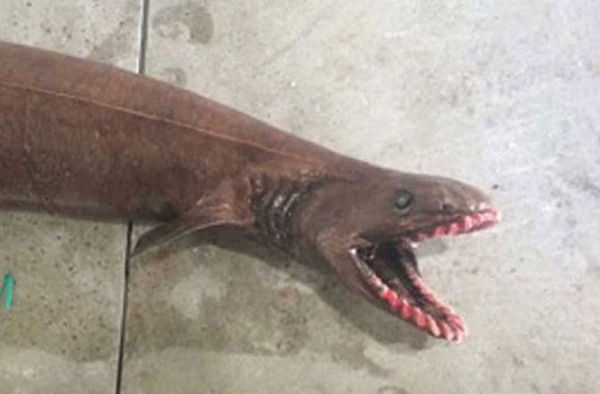
Pacu Or "Ball Cutter" Fish
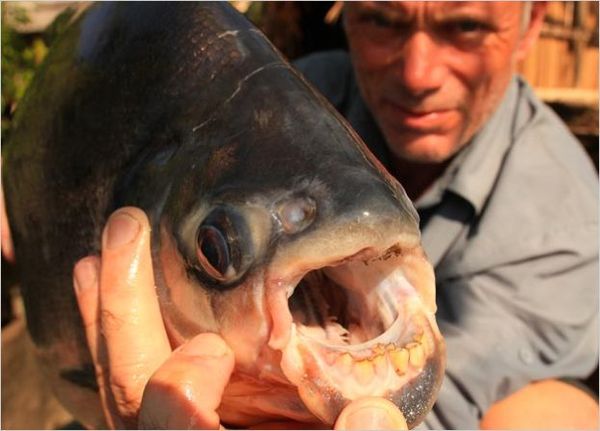
Pacu Or "Ball Cutter" Fish
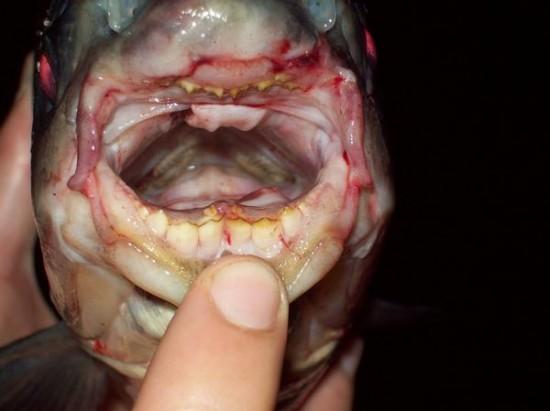
Stargazer Fish
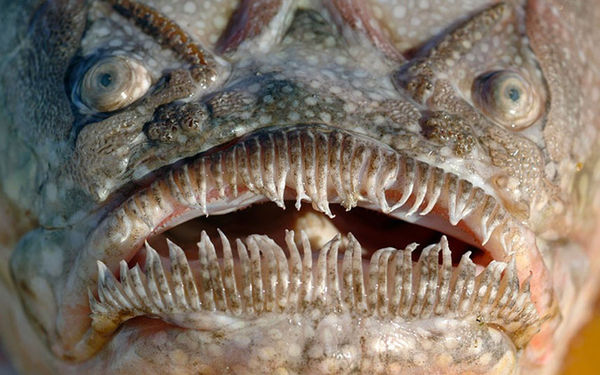
Stargazer Fish
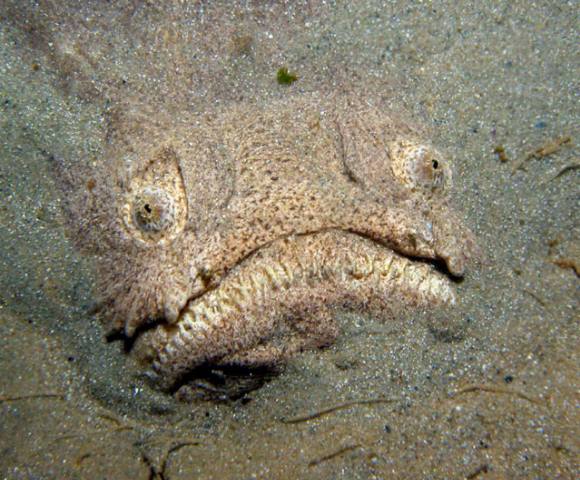
Pacific Barrel Eye Fish
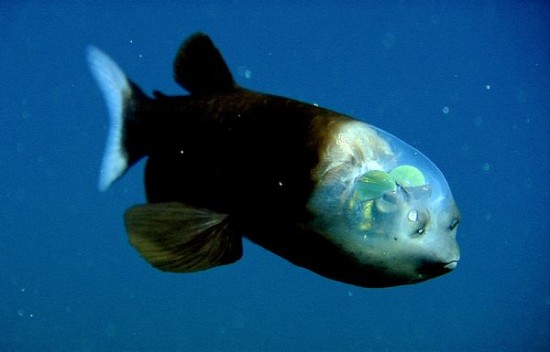
Pacific Barrel Eye Fish
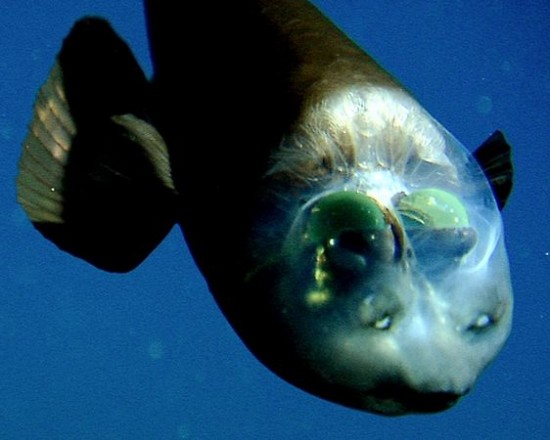
Blobfish
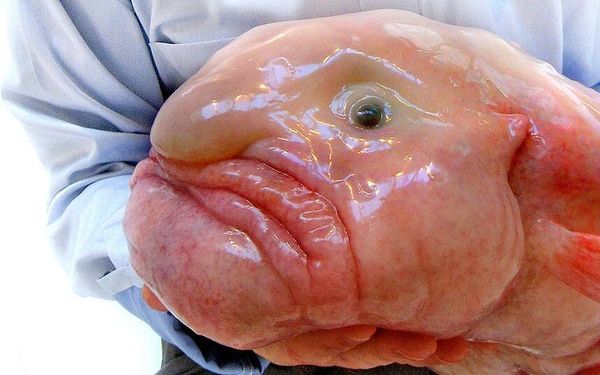
Blobfish
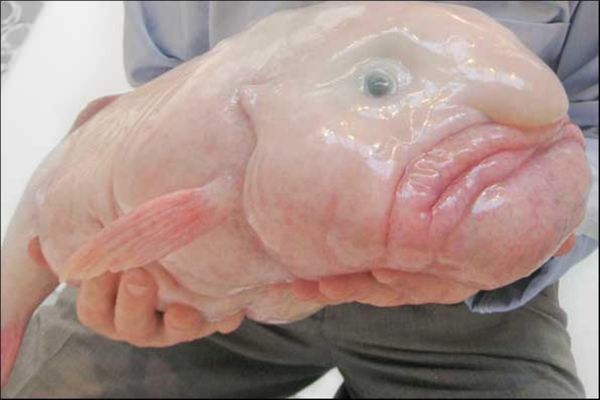
Blobfish
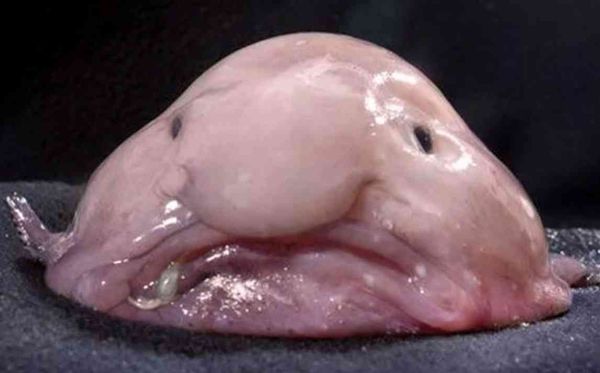
Dragonfish
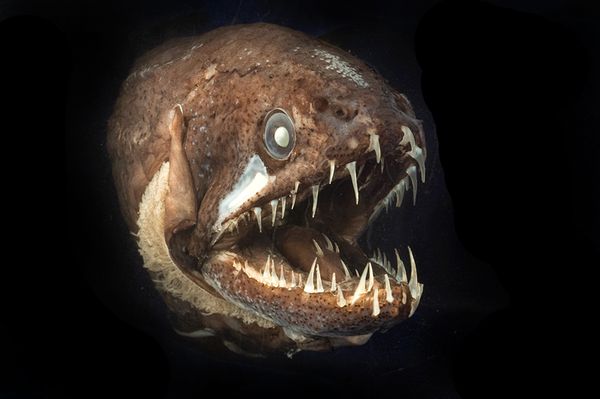
Rare Angler Fish (Only Five Of These Fish Have Ever Been Filmed In The Sea )
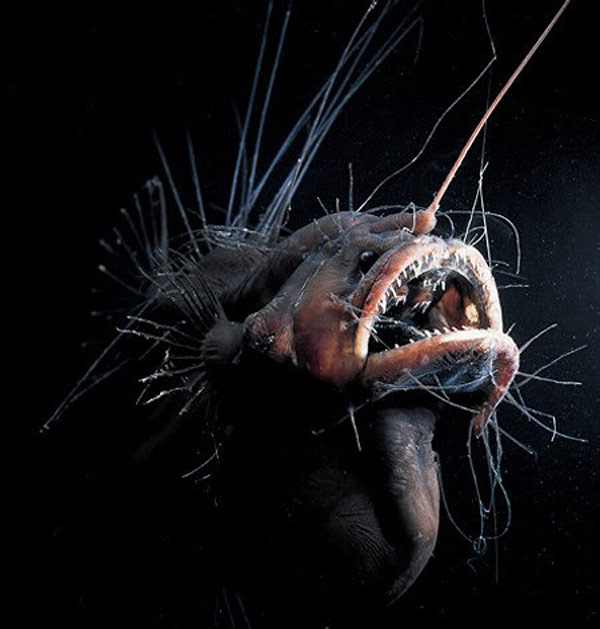
Vampire Squid
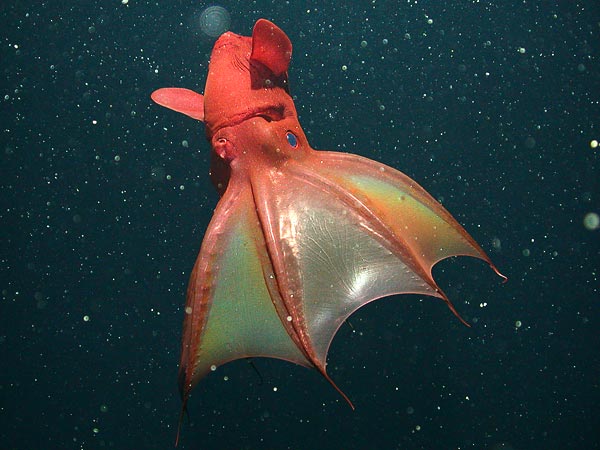
Vampire Squid
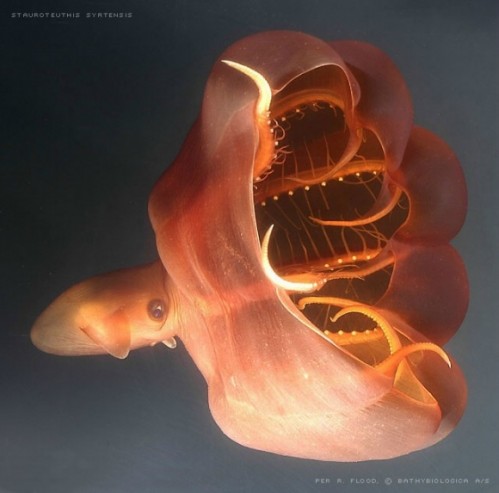
Vampire Squid
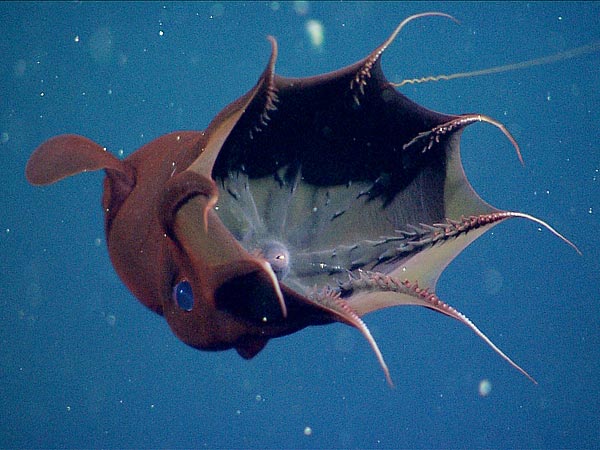
Vampire Squid
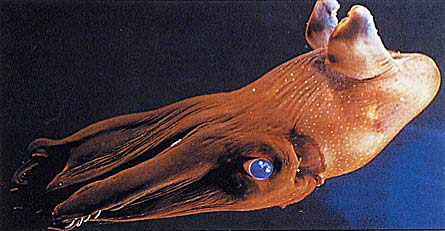
Snaggletooth Fish
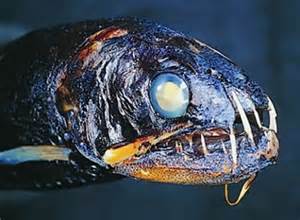
Viperfish
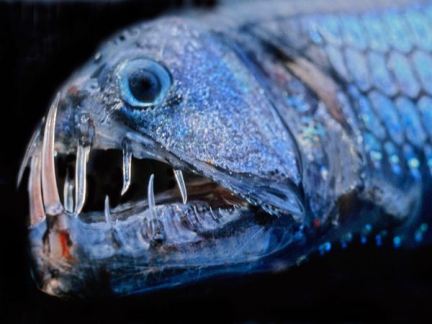
Viperfish
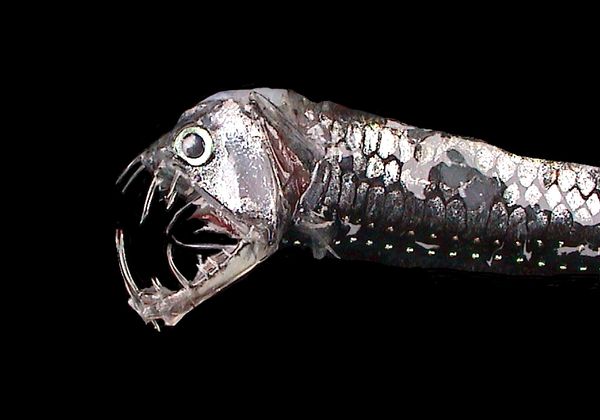
Goblin Shark
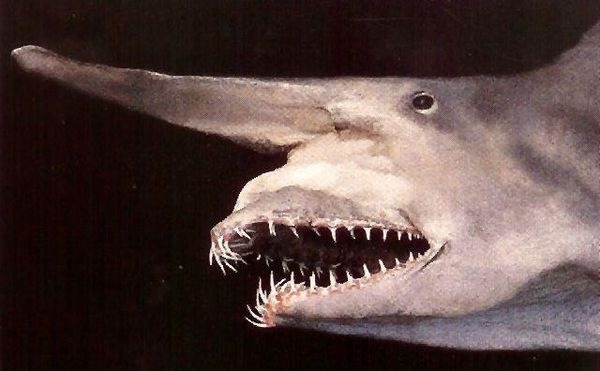
Goblin Shark
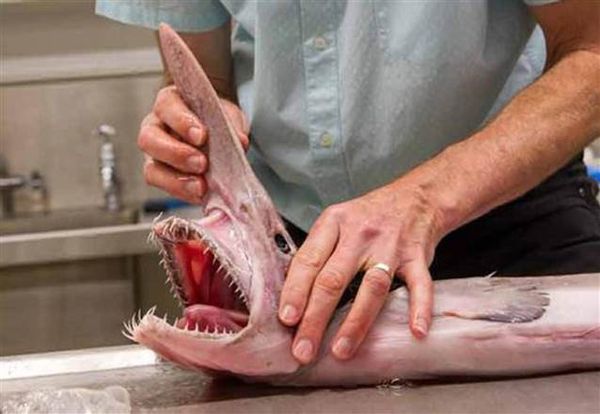
Apr 28, 2015 08:14:29 #
Apr 28, 2015 18:50:01 #
OnTheFly wrote:
Very strange creatures. Good post.
Why is this in the attic?
Why is this in the attic?
Why the Attic? Well, It's just about the only place I could put it; not many people look on "Chit-Chat" any longer, and if I had inadvertently posted it on the main photography forum, Dullshooter and a few more would be turning flip-flops, yelling and screaming, and even calling me all sorts of "unflattering" names! (Like they did a while back when I neglected to hit the button for "The Attic".
Apr 28, 2015 18:58:44 #
I understand. I didn't realize that chit chat wasn't being used much anymore. That's because I don't use it either.
I just knew that this couldn't be controversial. But, it does need to be where people will see it.
It is a good post. Makes one wonder what is down there that we haven't discovered.
I just knew that this couldn't be controversial. But, it does need to be where people will see it.
It is a good post. Makes one wonder what is down there that we haven't discovered.
Apr 28, 2015 19:07:11 #
Hey Gitzo. I got to thinking about how I worded my question about the attic...I do want you to know that I wasn't trying to be like those you mentioned. I thought you may have accidently done it. It doesn't matter where you put it. I enjoyed the photos.
I'm glad you did post it here because I would have seen it if you hadn't.
I'm glad you did post it here because I would have seen it if you hadn't.
Apr 28, 2015 23:17:00 #
Racmanaz
Loc: Sunny Tucson!
You really want to see something really amazing watch this.
http://www.youtube.com/watch?v=0b4tmbE5jj4
http://www.youtube.com/watch?v=t-LTWFnGmeg
http://www.youtube.com/watch?v=0b4tmbE5jj4
http://www.youtube.com/watch?v=t-LTWFnGmeg
Apr 29, 2015 01:14:20 #
OnTheFly wrote:
Hey Gitzo. I got to thinking about how I worded my question about the attic...I do want you to know that I wasn't trying to be like those you mentioned. I thought you may have accidently done it. It doesn't matter where you put it. I enjoyed the photos.
I'm glad you did post it here because I would have seen it if you hadn't.
I'm glad you did post it here because I would have seen it if you hadn't.
No problemo at all, OTF! I didn't think that at all; To tell you the t***h, I don't know what's happening over on "Chit-Chat" these days; when the Admin created "the Attic", I just started posting everything here, so I don't have to worry about what various people might think is "controversial" and what isn't.
BTW.....you mentioned, "what might be down there?" (in the depths of the oceans );
While I was doing research and a lot of reading to post these pictures, I ran across something that I had read about briefly once before, not long ago, which ties in nicely with what you were "wondering"....
Some time ago, researchers had caught and attached a very "high tech" tag to a nine foot great white shark. Great w****s are rather more "bulky" than most of the pelagic species of sharks, so a 9 ft great white is a pretty BIG fish! (maybe 24 inches in girth in the middle ) Smaller sharks get eaten all the time by "bigger" sharks, but by the time a great white gets to be 9 feet, the researchers reasoned that their 9 footer was of a size where nothing in the ocean posed a threat to him, which was why they wanted a really big shark to "wear" this very valuable research device.
They collected tremendous amounts of data from the tracking device attached to this shark, over quite a few months; how deep he had gone, how frequently he had gone deep, everyplace he had gone, etc. finally, (and all of a sudden ), the tracking device indicated that the shark himself had been "eaten" by....."something"! What ever it was, had apparently bitten this 9 ft great white shark completely "in two", and had swallowed the half with the tracking device, as it continued sending it's signals, only now the signals continued to come from a very deep depth. Some time later the other half of the shark washed up on an island someplace and the researchers were able to examine it. About the only two things in the ocean that are powerful enough to k**l a 9 ft great white, is either another MUCH BIGGER great white, probably a 20 or 22 foot great white, or else an orca. (k**ler whale ) Orcas have been known to k**l great w****s before, but probably not one this big. Giant squids have been suggested; they get really big, and are doubtless quite powerful, but I'm doubtful that even a giant squid could bite a 9 ft great white shark completely "in two"! So yes, there really are some amazing things "down there" in the extreme depths of the ocean!
Apr 29, 2015 08:28:42 #
Apr 29, 2015 08:32:28 #
That is amazing. Thanks for sharing.
Racmanaz wrote:
You really want to see something really amazing watch this.
http://www.youtube.com/watch?v=0b4tmbE5jj4
http://www.youtube.com/watch?v=t-LTWFnGmeg
http://www.youtube.com/watch?v=0b4tmbE5jj4
http://www.youtube.com/watch?v=t-LTWFnGmeg
If you want to reply, then register here. Registration is free and your account is created instantly, so you can post right away.

